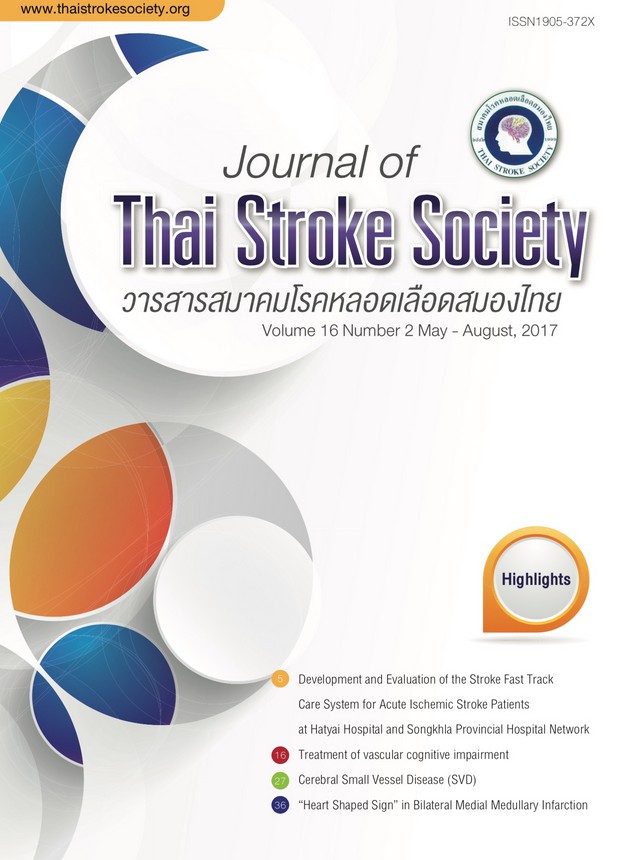“Heart Shaped Sign” in Bilateral Medial Medullary Infarction
Keywords:
Bilateral medial medullary infarction (MMI).Abstract
We present the report of a 70-year-old male patient who was admitted due to the problem of alteration of consciousness. Examinations revealed bilateral ptosis, vertical nystagmus, limitation of his movement of extraocular muscles on horizontal and vertical direction and quadriparesis. He was diagnosed with acute bilateral medial medullary infarction (MMI). The Magnetic resonance imaging (MRI) of brain showed ‘‘heart-shaped’’ hyposignal intensity area on T1-weighted, hypersignal intensity on T2-weighted, fluid-attenuated inversion recovery (FLAIR) and restricted diffusion on diffusion-weighted image (DWI), low signal in apparent diffusion coefficient image (ADC) at the bilateral upper part of medulla oblongata extending to the pontomedullary junction. Contrast-enhanced magnetic resonance angiography (contrast-enhanced MRA) of brain showed irregular narrowing of the left vertebral artery than the right side and atherosclerotic change of both middle cerebral arteries, both posterior cerebral arteries and basilar artery. He was treated with aspirin, atorvastatin and antibiotic for a problem of aspiration pneumonia. He was on physiotherapy and rehabilitation, required tracheostomy and percutaneous gastrostomy tube placement, with no paralysis resolution.
References
Toyoda K, Hasegawa Y, Yonehara T, et al. Bilateral medial medullary infarction with oculomotor disorder. Stroke 1992; 23: 1657-1659.
Katoh M, Kawamoto T: Bilateral medial medullary infarction. J Clin Neurosci 2000; 7(6): 543-545.
Nakajima M, Inoue M, Sakai Y. Contralateral pharyngeal paralysis caused by medial medullary infarction. J Neurol Neurosurg Psychiatry 2005; 76: 1292-1293.
Kim JS, Han YS. Medial medullary infarction: clinical, imaging, and outcome study in 86 consecutive patients. Stroke 2009 Oct;40(10):3221–5.
Kumral E, Afsar N, Kirbas D, Balkir K, Ozdemirkiran T. Spectrum of medial medullary infarction: clinical and magnetic resonance imaging findings. J Neurol
2002 Jan;249(1):85–93.
Tokuoka K, Yuasa N, Ishikawa T, et al. A case of bilateral medial medullary infarction presenting with “heart appearance” sign. Tokai J Exp Clin Med 2007;
32: 99–102.
Maeda M, Shimono T, Tsukahara H, Maier SE, Takeda K: Acute bilateral medial medullary infarction: A unique “Heart Appearance” Sign by diffusion-weighted imaging. Eur Neurol 2004; 51: 236-237.
Searcy S, Akinduro OO, Spector A, Yoon JW. Heart-Shaped Bilateral Medullary Pyramidal Infarction as a Pathognomonic Finding of Anterior Spinal Artery Occlusion. Neurocrit Care. 2017 May 8. doi: 10.1007/s12028-017-0406-7
Powers WJ, Derdeyn CP, Biller J, et al. 2015 American Heart Association/American Stroke Association Focused Update of the 2013 Guidelines for the Early Management of Patients With Acute Ischemic Stroke Regarding Endovascular Treatment: A Guideline for Healthcare Professionals From the American Heart Association/American Stroke Association. Stroke 2015 Oct;46(10): 3020-3035
Pfefferkorn T, Mayer TE, Opherk C, et al. Staged escalation therapy in acute basilar artery occlusion: intravenous thrombolysis and on-demand consecutive
endovascular mechanical thrombectomy: preliminary experience in 16 patients. Stroke 2008 May;39(5):1496–500.
Kim H, Chung CS, Lee KH, Robbins J. Aspiration subsequent to a pure medullary infarction: lesion sites, clinical variables,and outcome. Arch Neurol
2000;57: 478–83.
Ho MW, Fardy MJ, Crean SJ. Persistent idiopathic unilateral isolated hypoglossal nerve palsy: a case report. Br Dent J. 2004 Feb 28;196(4):205-7.
Downloads
Published
How to Cite
Issue
Section
License
ข้อความภายในบทความที่ตีพิมพ์ในวารสารสมาคมโรคหลอดเลือดสมองไทยเล่มนี้ ตลอดจนความรับผิดชอบด้านเนื้อหาและการตรวจร่างบทความเป็นของผู้นิพนธ์ ไม่เกี่ยวข้องกับกองบรรณาธิการแต่อย่างใด การนำเนื้อหา ข้อความหรือข้อคิดเห็นของบทความไปเผยแพร่ ต้องได้รับอนุญาตจากกองบรรณาธิการอย่างเป็นลายลักษณ์อักษร ผลงานที่ได้รับการตีพิมพ์ในวารสารเล่มนี้ถือเป็นลิขสิทธิ์ของวารสาร





